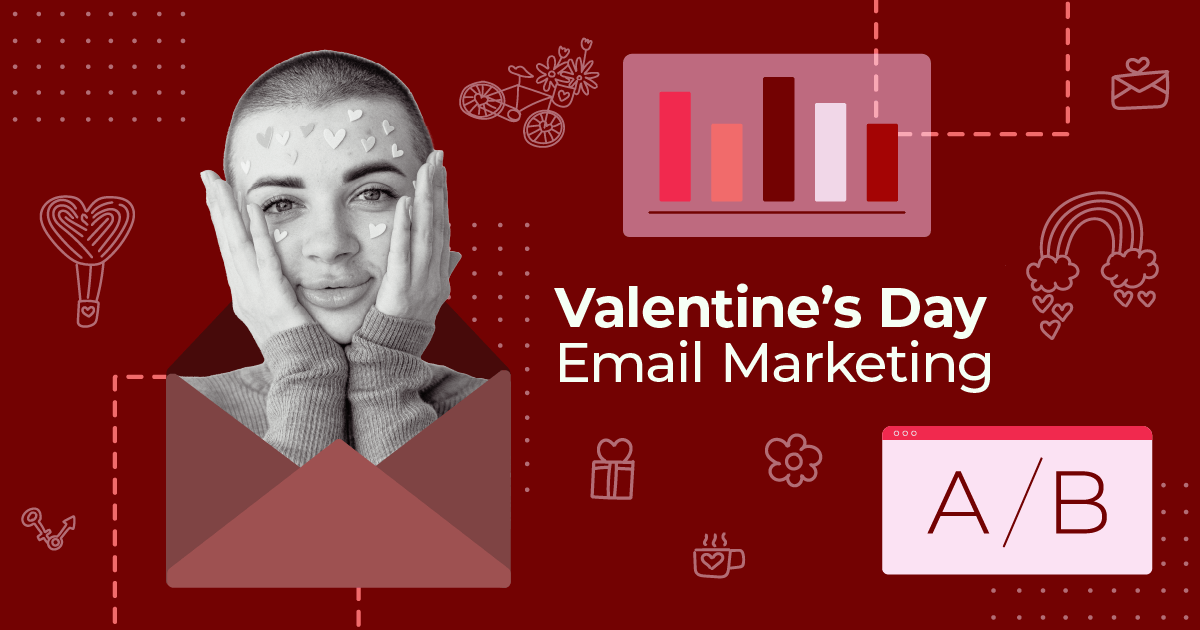
Email Copywriting: Write Email Copy That Converts In Minutes
Does email copywriting make you feel blue?
Does email marketing make you feel like you don’t belong?
Do you like receiving useful, well-crafted emails, but loathe trying to make them yourself?
I am back y’ all, and I would like to welcome you to yet another one of my TED talks. Today, we’re going to delve into the complex world of email copywriting, which doesn’t need to be that complex.
If you’re a fantastic marketer but not the best copywriter, if you’re only just starting or want to enrich your knowledge, you’ve come to the right place.
But before we even begin, we highly suggest that you take a look at our relevant Youtube video, where we explain how to up your email marketing copy game in 5 easy steps.
Let’s begin!
What Is Email Copywriting?
Email copy is something that confuses even the most experienced of marketers, even though they won’t admit it.
Email copy, to put it simply, is a term for all those words you’ll put into place in your email, to convince, convert prospects, and reach your marketing goals.
So, from your subject line to your body copy, your CTA, and your email sign-off, there are specific techniques you should follow, to turn yourself into an experienced email copywriter.
However, unlike advertising copy, social media copy, and… Well, all other types of copy, email copy has some core characteristics:
- It needs to be highly persuasive in as few words as possible, which means no fluff content!
- You need to create a clear connection between your subject line, copy, and CTA.
- Excellent copy should be able to turn reading the email into an interactive experience – i.e., make the reader click on a link or your CTA or spend some time on the email itself and share its content around.
- You need to apply SEO copywriting principles if you want your email to stand out.
All of the above don’t come easy, of course. Email copywriting is a difficult job. It requires excellent written skills, creativity, an eye for detail… But it’s not a tedious task; I’ll tell you that!
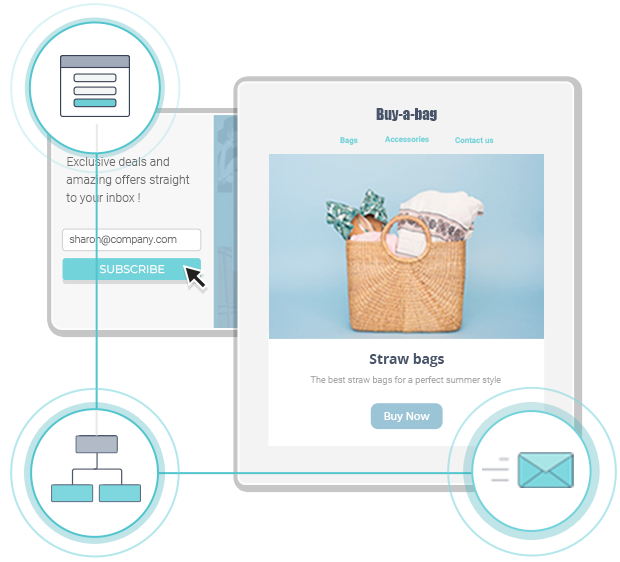
The easiest and most affordable email marketing and newsletter software!
The Benefits of Writing Pristine Email Copy
Email copywriting comes with a series of significant benefits.
“But Téa, whatever do you mean by that?” Yeah, I heard the question.
A successful email campaign comes after defining an actionable goal as a marketer. And so far, we all know that marketing emails can achieve a lot more than other marketing channels can.
Let’s assume that you’ve managed to build an email list of email subscribers that is healthy and well-curated. This is only a means to an end. In our case, it is a way to create an open dialogue between your brand’s value proposition and your potential customers.
An email campaign that comes with actionable language and can further promote your brand and services is an effective one. Furthermore, it can help you reach all the goals you visualized and set when you created your marketing plan.
An email copywriter has some specific objectives, much like a marketing strategy does. Therefore, email copywriters create email copy that will interest the brand’s email list. But those benefits I mentioned above? What about those?
- Excellent email copy will gently lead the prospects to the action you’d like them to take.
- An engaging email will make prospects spend more time on it. Increased time spent reading an email and interacting with the content will increase the possibility of your brand being memorable.
- Email copy that converts can help you reach all the marketing strategy goals you’ve set, making your brand more profitable.
Email Copywriting: The Main Components
How can you write the best email you’ve ever sent? How can you put the fancy email newsletters you receive, to shame?
You can’t possibly do that without understanding the main components of email copywriting.
First things first, you need to understand what makes an effective email campaign. Understanding these components will give you more clarity when crafting your email content.
- You’re writing for your target audience.
- You need to stand out in a full inbox with a crafty email subject line – this will give your email campaign a high open-rate.
- Never forget the body content. You need a high open rate and a high click-through rate.
Okay, I hope you’ve got those down – we’ll be circling back to the points above in a minute. Now, let’s continue.
What makes a marketing email great?
Email Subject Line and Preview Text Magic
![]()
The first things a prospect will notice upon accessing their inbox are your email subject line and your email’s preview text. So check out the fine specimen above.
This email marketing campaign’s goal was to announce and promote our brand new Moosend Academy, the project that aims to educate marketers, entrepreneurs, solopreneurs, and everything in-between.
An email subject line that would be telling things “as is” was in order. Of course, this didn’t mean “be plain and bland”, it was more like “let’s get straight to the point”.
The emoji helped the subject line – and the email itself – stand out, and the preview text was a clear indication of what the recipients most likely thought when they received this email: “Let’s go watch.”
Now, on to the second component of email copywriting…
The Fancy Email Body Copy
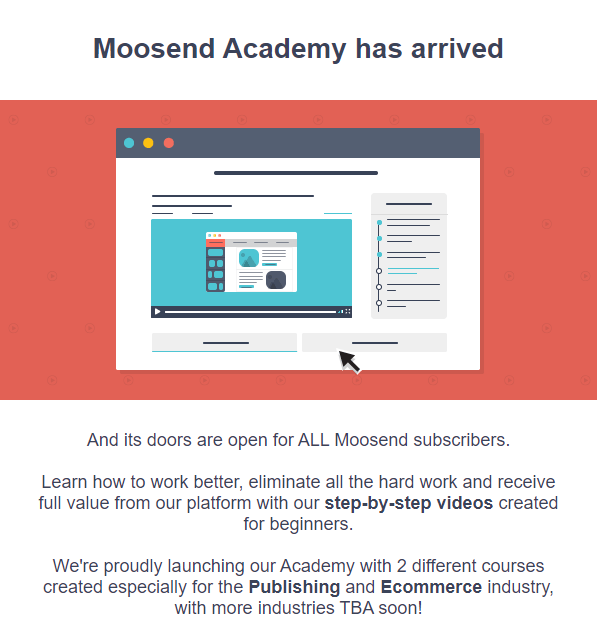
Our subscribers opened the email and were expecting to see some fancy body copy that would tell them more about the “Breaking News” the subject line was speaking of.
And they got that right.
As you can see, the body of the email is short and informative. What is Moosend Academy? What does it aim to do?
A copywriter needs to let the prospects know the information that will make them click the CTA button. A good email should invite users to learn more by following the action you need them to follow.
The Actionable CTA


It makes you wonder, doesn’t it? Why two CTAs?
Well, it’s because we needed the prospects to perform two different actions. They could pick and choose the action they preferred, of course, but both were equally valid since the first one would lead them to a blog announcement of our Academy, while the second one would redirect them to the page where they could watch the first two informational videos.
By using actionable verbs, marketers manage to capture the reader’s attention and reach a specific goal.
Whether you need to lead your prospects to an optimized landing page or want them not to abandon their cart and continue to checkout, using verbs that are directly connected to your body copy when crafting your CTA is the way to go.
That way, no prospect will have any questions on the action they’re supposed to take after reading your email or will find it tedious enough to unsubscribe – provided you do things right.
The Email Copywriting Tips You’ve Been Waiting For
We went through what email copywriting is, the main components of successful email content that all copywriters should keep in mind, and why content marketing and email marketing go hand-in-hand.
Understanding those steps might be crucial for the success of your email marketing strategy. However, you need email copywriting tips in particular. So, without further ado…
Email Copywriting Tip #1: Personalization
Personalization is here to stay, and personalized copywriting will make your email marketing campaign fly oh-so-very-high.
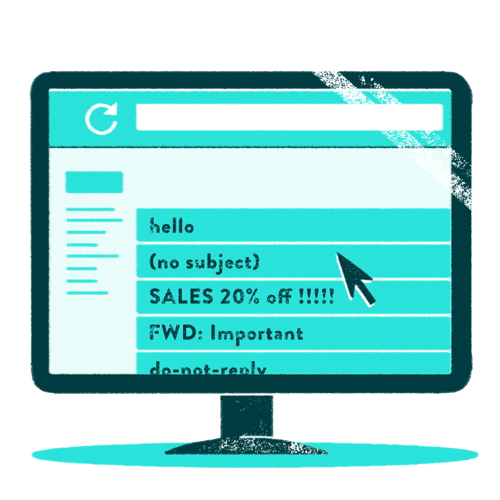
This is an example of what not to do.
When I’m talking about personalization, I don’t mean that you should just include the prospect’s name to your email or the body copy. You need to stand out.
First of all, make sure to create a body copy that will make it seem like you’re talking to your prospects in the second person.
Don’t just showcase your Unique Sales Proposition (USP) or the brand new offer (if you’re an eCommerce brand), feature (for those SaaS people we love), or post you’ve created. Make the user realize that all of the above are mentioned, precisely because your brand cares about them.
Let me give you a great email copywriting example:
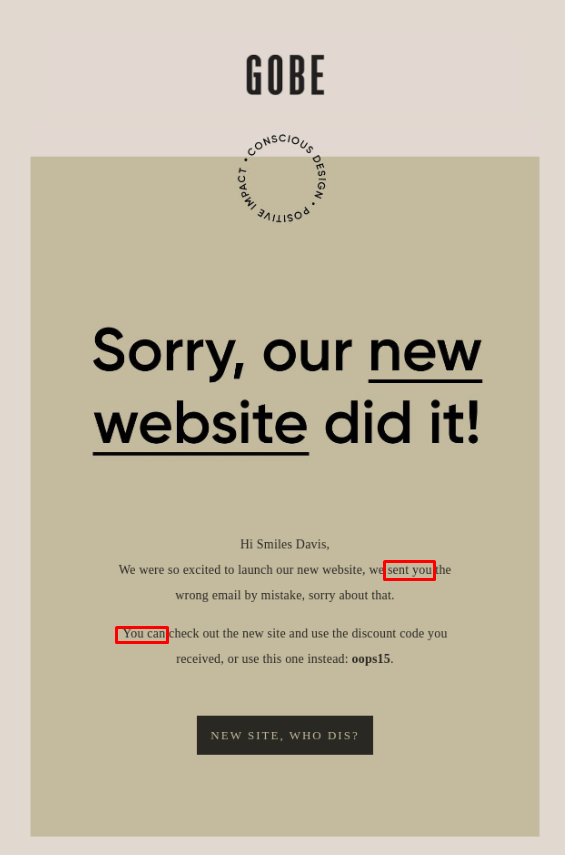
(Source)
This email was a result of the brand sending out the wrong marketing email at first. You can see how it puts the reader front and center, just by mentioning the name at first and then using the word “You”. “You can check out”, “You can use the discount”.
The more you go about segmenting your audience and studying your buyer personas, the better.
To personalize, you need a crystal-clear image of who you’re sending the email to and the type of action you want them to take after reading it.
Is it a product announcement? A plain email newsletter? Do you need to create a sense of urgency? Are you talking to a blogger? An entrepreneur? A single mother that has practically zero time for emails?
Understanding your audience is the first step towards building trust and a memorable brand.
Making timely and relevant suggestions, studying your data, and investing in AI technology will be your saving grace, along with making sure to use email triggers to send memorable emails that will be timely and relevant.
Remember, an email that doesn’t resonate with your target audience is an email that will go straight to the trash bin.
Are we clear on how a great email begins with great email personalization? I think we are. So, let’s move on.
Email Copywriting Tip #2: Pain Point and Relevancy
Yes, yes, I said it before, and I’ll repeat it, relevancy and addressing your customer’s pain points are the two most important things you can do if you want better conversion rates.
With an average of 200 emails in an inbox, what you need is to stand out. And you can’t do that if your emails are not relevant and your email marketing copy doesn’t address your prospects’ pain points.
After all, you want to be the one who stands out among those 200 emails, am I correct? But let’s see how you’re going to do that.
Studying your data is crucial here, as was with personalization. A reader will just take a look at your subject line and decide whether you’re worth their time or not, in seconds. This would be the time and place to address a pain point.
Let’s assume that you’ve launched a new product, and you want the whole world to know because yeah, it’s an excellent product, and why wouldn’t you?
You need to set a product launch email campaign, isn’t that correct? This email will most likely end up in the Gmail Promotions tab. Now, all of us know that prospects check the Gmail promotions tab at least once a day. What kind of email copy would boost your conversion rates?
The answer: The kind that addresses the prospect’s concerns and provides a solution to their problems. Like this:
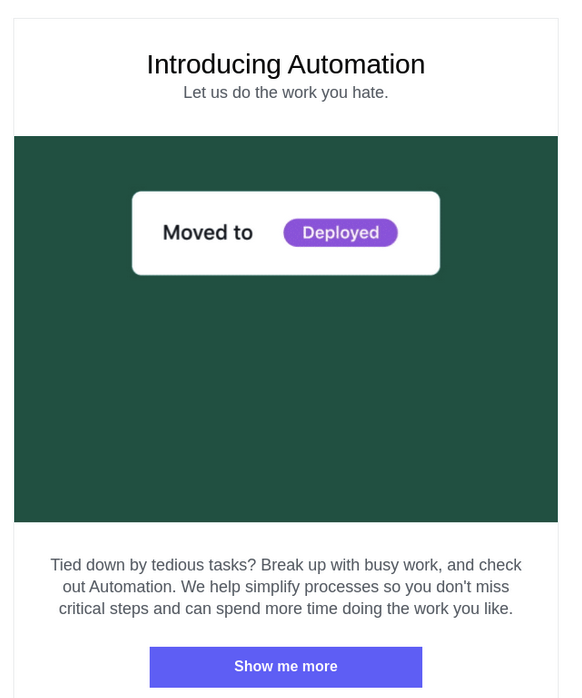
(Source)
This is a product launch email from Asana, an app that aims to help teams manage their workload.
The email is addressing the pain point of the customer right from the very beginning: “I have something that will do the work you hate”. Its subject line is something along those lines as well:
![]()
With a subject line that promises to introduce a way for the prospects to complete their tasks without hating the time they have to spend to do so, the email copywriter made sure that the subject line – and the body copy, I may add – addresses and eliminates the concerns a prospect may have.
And how does the copy do that? By addressing those concerns. “Tired..?” “Break up with tedious work” “We simplify the process”. These key phrases make prospects think that they’ve found the tool that will make their lives easier.
Now, as for the relevancy. I’ll take the above email as an example again and say the following:
Would it be a successful email campaign if out of all of the email templates, you went with the minimalistic one above and sent it to my mother?
No. The answer is no. Not just because my mother likes simple but pretty things – and floral works beautifully for all boomers – but also because my mother couldn’t care less about some automation tool that promises to make the team’s job a little easier.
She doesn’t run a team, after all.
Sending the right email to the prospect that needs to see it at the right time is the key to unlocking your full potential, boosting your conversion, and, in the end, your bottom line as well. And segmentation and heavy personalization is the only way to do this.
Email Copywriting Tip #3: What Is It That You Offer?
Does this question sound too simplistic? If your answer is yes, you need to keep reading!
All of us have received email newsletters that made no difference in our lives, despite them being very comprehensive and well-written, with actionable CTAs. But these email newsletters were in no way better than the next email. Ever wondered why?
Ah, don’t think about it too much, the answer is very simple.
You know your product, you know how awesome it is, and you know why your email warrants a follow-up with a better email that will hook your target audience and lead them further down the funnel.
However, you don’t know why the audience will pick your product, out of all of the products on all the emails in all the world.
You know why your product works and what solutions it provides, but how do these solutions help your prospects? How do you answer the question “Why should I buy this?” with your email?
Use the micro-segments you’ll see in your data. Distinguish the patterns with the help of AI. Now, write a subject line and email copy that will be showcasing how your product can solve a problem. Like so:

(Source)
The solution is evident. What would the target audience want from an email like that? It’s right there on the subject line!
Let’s take a look at the body copy now:
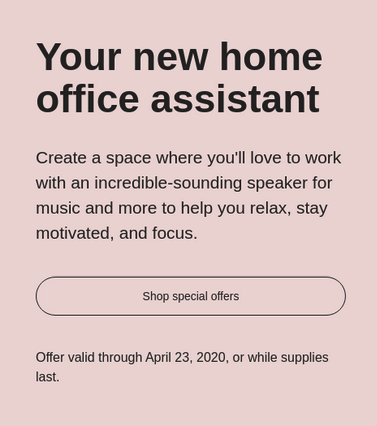
So, the subject line uses an actionable verb as a CTA. More specifically, the word “Upgrade”. Does having a home office assistant that will create a unique WFH experience sound like an upgrade?
The answer would be yes. So, to answer the prospect’s question, they need this product because it’ll make working from home more relaxing, and it will keep them motivated and focused.
This brand is a great solution to keep prospects motivated and relaxed, which is the benefit of the product in and of itself. And this is what the brand is offering at the end of the day.
Email Copywriting Tip #4: The 4 P’s
In other words, “Promise, Paint, Push, Proof”, the 4 P’s formula promises to help you create email newsletter copy that your prospects will love.
Much like the AIDA model and other sales models, the 4 P’s formula is created to present an offer in a manner as lucrative as possible, all the while allowing the email copywriter to have a framework in which they can work.
So, let’s see what these P’s are!
The Promise
There are billions of email copywriting tips on how to make a promise to your readers without sounding spammy and just as many tips to avoid spam emails.
Now for just as many – billions, that is – reasons, you want to steer clear of the spam folder’s path, as it can mess with your email deliverability, and you can end up being penalized by various email clients as well.
So, begin by making a promise that is not misleading and speaks to your target audience’s hearts. Here’s a great example:
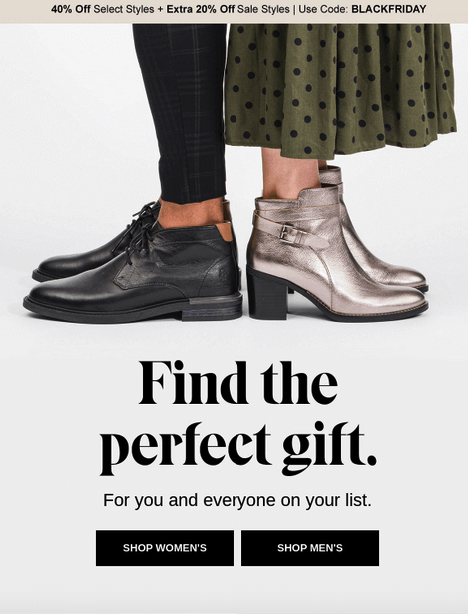
(Source)
“Find the perfect gift”. This is all you need; this is the promise the reader wants to proceed with a purchase, provided there’s a holiday coming up, and they’ve already started their holiday shopping.
The above email is, conveniently enough, a Black Friday email. See where I’m going with this?
Its structure is plain, simple, the colors are very calm, and the CTA stands out: “Shop Women’s” or “Shop Men’s”. Actionable, clickable, will take the user straight to the website and then let the conversion begin!
The Paint

Be the Bob Ross of email copywriting!
If you don’t paint a picture of how your product or service can – and will! – change a prospect’s life, your email copy is doomed.
Painting a picture is, again, directly tied to what your prospects want, what they need, and what they already have.
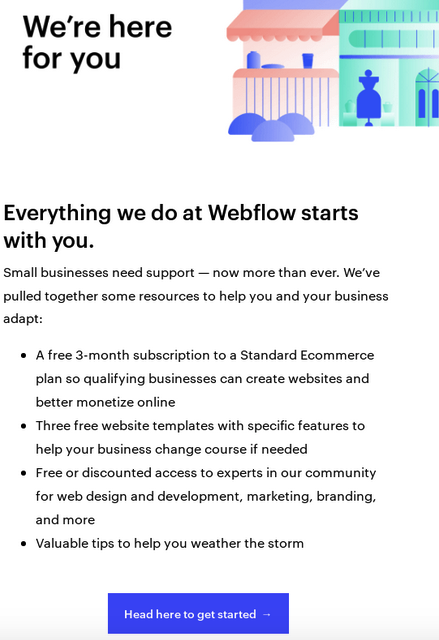
(Source)
When the picture is painted with great email copywriting examples like the one above, it’s hard not to convert.
It shows small business owners what the product can do and how with free tips and a free 3-month subscription, they can monetize all their efforts.
What’s not to like?
Pro tip: There is nothing that paints a picture better than a video. If you want to implement the 4-P’s formula, using video email marketing is practically a no-brainer.
The Proof
Let’s say that you’ve created an email campaign, and it looks great. You used every SEO copywriting tip and SEO tactic in the book. Everything is set and ready.
Right?
Oh no, this is so very wrong. Where’s your social proof? How will your prospects know that your email is valuable and that they can’t possibly live without your brand?
Your best shot is to show the impact your product or service has made on others’ lives:
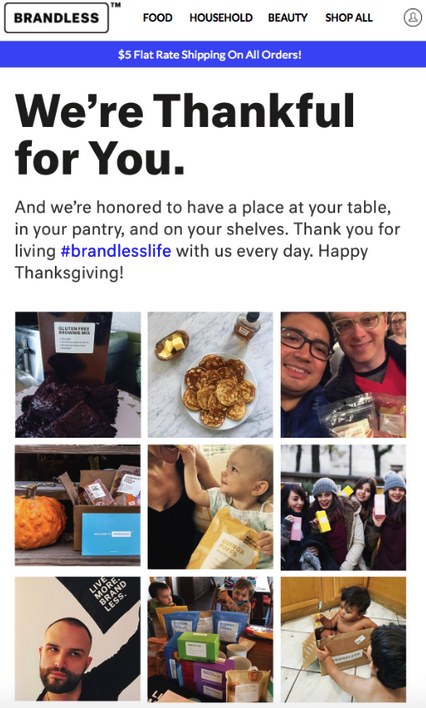
(Source)
Yes, I know what it looks like. You see pictures of people using the products and being happy about it, thankful even – since it’s a Thanksgiving email… Geddit?
Oh well, it looks like an Instagram influencer marketing campaign. And the reason is that the “Proof” aims to do the same thing: use photos, reviews, everything that’s designed from people to people, to build a trusting relationship with the audience.
In this case, the people using the product serve as influencers – or brand ambassadors if you will – and boost your social proof score, showing the rest of the prospects what their lives are like when using your product.
The Push
The final step in the 4 P’s formula. The push shows how you gently nudge your audience to click on your CTA, aiming for them to “land” on your landing pages or website.
The key here is to write email copy that will get them all excited and happy to take the action you’re proposing.
Show them how your product is what will lead them to succeed.
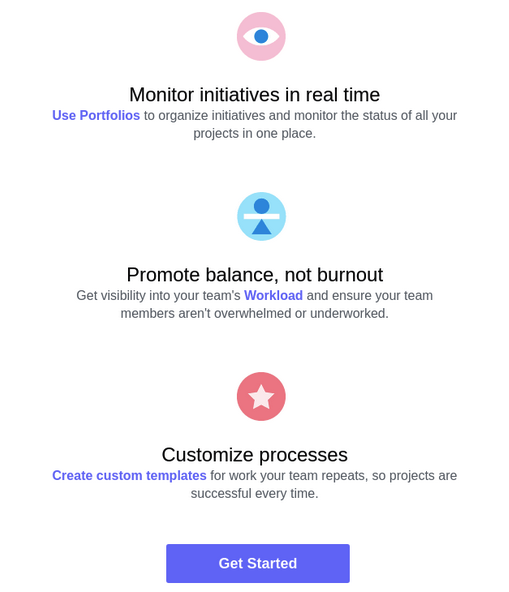
(Source)
The email copy above shows the reader how this product can help them be successful in their work by doing specific actions. Who wouldn’t be excited to “Get Started”?
Before I continue to the final part of my email copywriting examples, tips, tricks, call it what you will, I need to stress the importance of one single component that should be a prerequisite by now: A/B testing, guys!
Use A/B testing right after you check your data and the patterns in them and right before you decide on the email copy that would rock your recipients’ world!
Create two versions of each thing you want to test, whether it’s the email newsletter template itself or the subject line or CTA, and change each version slightly.
Then, track the results according to the marketing strategies you follow and the goals you’ve already set when creating your marketing plan.
A/B testing will reveal exactly what you need to know about your audience: What makes them click on your email and not just swipe and send to trash? What makes them click on your CTA button?
In the end, what is it that makes a difference?
Okay, okay, I babbled enough… Now, I want to take you down the final path.
Email Copywriting for the Subject Line and Body Copy
I can hear you asking “What were you saying all this time if not talking about the subject line and body copy?”. Well, this title is there simply to hook you.
Do you see where I’m going with this? No?
Email Copywriting for the Subject Line
You thought this was all over and done with? Oh no, my sweet summer child, it was not. The email subject line is, as I love to say, “a knock on the door”. I don’t want you to knock without an answer.
Yes, you need to be clear and specific when creating your subject line. After all, false advertising can land you in the spam folder.
However, what is life without a little risk and curiosity? Ah, it’s food without any seasoning at all. Imagine what that would taste like.
Don’t get me wrong; I don’t mean that you need to be cryptic and vague or mysterious. But you need to create a question mark in the prospect’s head.
One of my favorite newsletter examples was and will always be TOMS “We’ve got a story to tell”. And if you click the link above, you can read the whole story of this email newsletter.
I need to stress two things when it comes to this email newsletter subject line:
- It makes the prospect wonder “What”. It’s not a promise; it hooks them by making them curious.
- It doesn’t make false promises. The email does tell a story. It tells the origin story of the brand and how TOM means “Shoes for Tomorrow”. Fascinating!
Be brief and cryptic to generate a higher open rate
More than 60% higher, to be exact:

(Source)
Of course, generating curiosity is just a mind game and it stands no chance of converting if you use it without thinking.
Curiosity can be generated by asking a straightforward question, as you saw in the statement above. It might be one of the oldest subject line tricks in the book, and it’s one of the oldest sales tricks in the book, but it works.
Ask questions that can generate one small “Yes” each time:

(Source)
And here’s the subject line:

The answer can be either yes or no, but it hooks the reader. What would that question even mean? And BOOM! They open the email.
Of course, I wouldn’t even want to think of what would happen if your email copy on the subject line doesn’t match what’s inside. Don’t ever think of building a relationship by writing clickbait titles; you’ll never hear the end of it!
Just make sure that you’ve got the following clear when it comes to your subject line:
- If there’s a promise, it creates an “Okay, and?” question.
- If there’s a cryptic message, it creates a “What do you mean?” question.
- If it’s a question, it creates curiosity all the same.
All three are the same and should be treated as such. Even a question can create expectations. Especially if they match…
Email Copywriting for the Body Copy
The body copy is just as important and should be aligned with the subject line at all times.
Your subject line is what one would call a “summary.” Your body copy though is your story. It needs to go a little more into detail regarding your offer or the benefits of your product.
Aligning your subject line, body copy, and, of course, the CTA can build trust between the prospects and your brand. After all, prospects clicked on your email to read more about what the subject line was talking about.
You can’t trick them with unrelated content.
If you want to give a full picture and ease them into clicking your CTA, you can use storytelling that will be relevant to your subject line.
No email marketer and email copywriter is stranger to compelling storytelling.
I will circle back to the TOMS email I mentioned above. I was amazed by how they managed to tell the brand’s story while having zero space and managing to make me click on their CTA all at the same time.
It was engaging, it showcased the brand’s values correctly, and I couldn’t wait to see the corresponding web pages’ images and design. That was because storytelling creates emotions, images, and thoughts that can influence decisions.
And if you manage to create a correlation between those positive feelings and reactions, and your brand, in your target audience’s mind… Then you’re in for a real treat!
Summing up and Taking It Away
Email copywriting is no easy task, and it requires resilience, constant updating, and studying of your data, tests after tests… But here are the basics you need to remember:
- Think like a consumer before you think like a marketer. After all, you belong to someone’s target audience. If you were to receive your email, what would make you proceed with the desired action?
- Don’t babble. An email needs to be short, sweet, and comprehensive. You wouldn’t interact with a long email any more than one of your prospects would.
- Be relatable, relevant, and address the prospects’ pain points and solutions. Your target audience doesn’t care about the product’s benefits, but they do care about how it can change their lives.
- Use actionable language, especially for your CTA. Tell your prospects to “Click”, “See”, “Buy”. Show them the action they need to take.
- Don’t be faceless. This is why storytelling is so important. It showcases your brand’s values and tone in a manner that allows prospects to relate. After all, all of us have a story to tell.
Don’t be afraid to implement the tips and tricks above and always experiment. Oh, and if you’ve got a good suggestion for me, tell me in the comments!
Until next time, this was Téa, and thank you for coming to my Ted Talk!



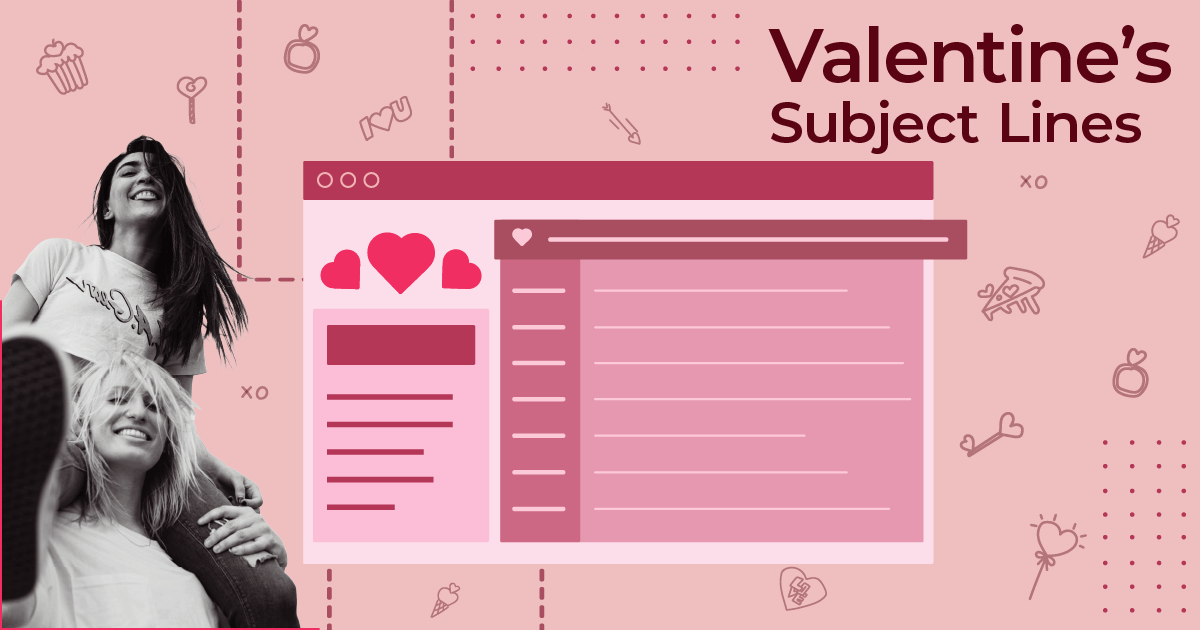
 Published by
Published by
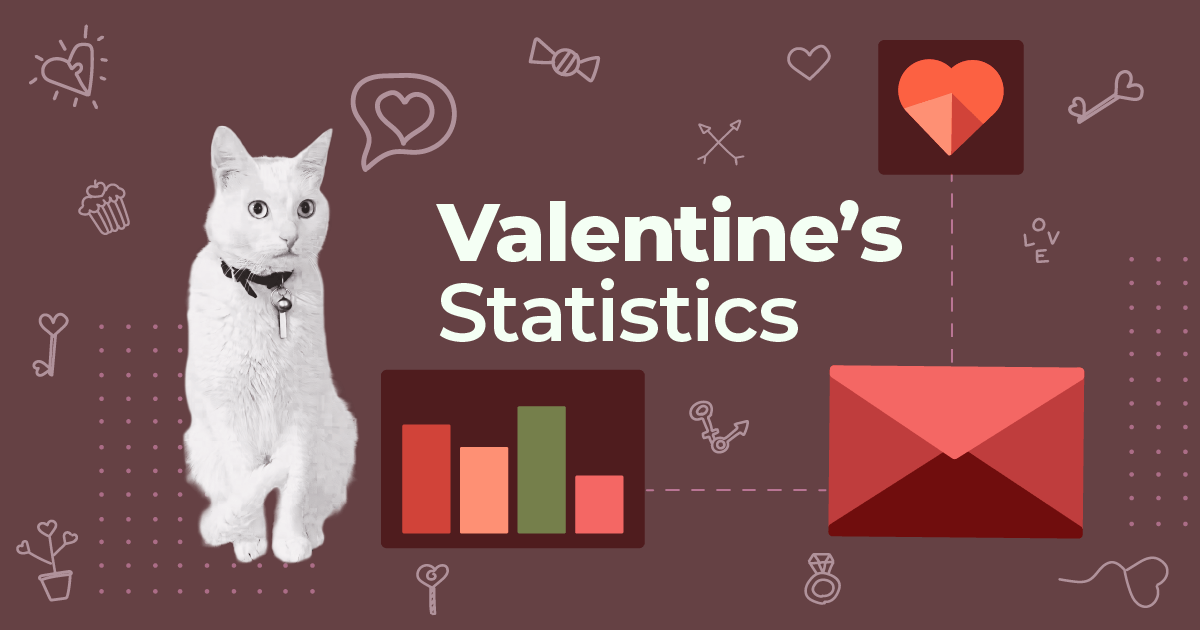
 Published by
Published by
